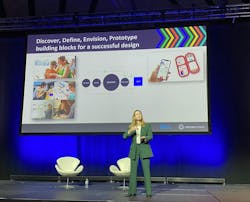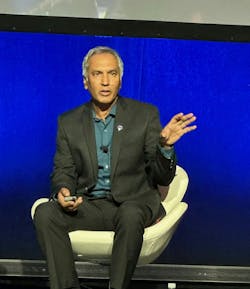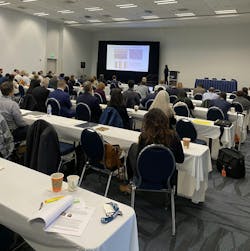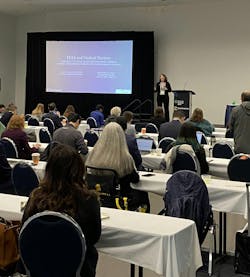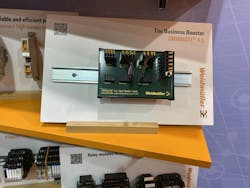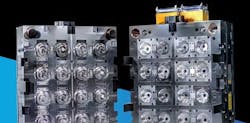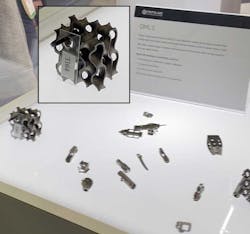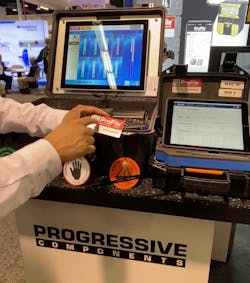Insights from MD&M West: Keynotes, Sessions and Exhibits
MD&M West, the annual B2B medical device show that brings together a host of MedTech companies, was co-located with four other show brands—ATX West (automation), WestPack (packaging), D&M West (design) and Plastec West (plastics manufacturing)—under the umbrella of IME West 2024 and took place Feb. 6-8, in Anaheim, Calif.
The medical devices industry has grown strongly in recent years and is forecast to continue this growth, climbing more than 5% a year to reach nearly $800 billion by 2030, according to KPMG. These figures are indicative of demand for innovation in new devices and services such as wearables and data-driven offerings.
The medical design and manufacturing event addressed this growing demand for innovation via a host of sessions and exhibits for medical device engineers, including keynotes that did not disappoint.
Flex’s Samproni on Integration for Patient Outcome
In her keynote address Transforming the Future of Patient Care with Human Machine Interfaces, Jennifer Samproni, CTO of Flex’s Health Solutions business, shared her perspective about how HMI can impact patient outcome.
Speaking directly to the makers and builders in the audience, Samproni said, “We’re not just designing the devices; we are creating the experiences that will improve patient outcome and improve patient care.”
She says our responsibility with HMI is to leverage technology and blend it seamlessly with the human experience and the human touch. Augmented and virtual reality will play a role in this. “As we move to AR and VR and HMI into the medical segment, we’re able to simulate and craft user experiences in real time,” she said. “In fact, we’re seeing a revolution in medical education, telemedicine, and remote patient monitoring and diagnostics."
Samproni addressed the four megatrends that she sees as disruptive forces in this space.
- The first is an aging population—one that is older now than it has ever been. The median age went from 30 years old to 39 years old between 1980 and 2022, she noted, and one in six people have a chronic disease, including stroke, cancer, diabetes and heart disease. She says we expect a 47% increase in the number of people who are 65 years old and older between now and 2050 in the U.S.
- The shifting sites of care is another disrupting factor. With hospitals being overburdened and overrun, it is becoming more challenging to find skilled labor. “Add to that, that according to the CDC, one in 31 patients on any given day will have a hospital-acquired infection,” she said. This is why it makes sense to move care outside of the hospital to points of patient need except for the more critically ill patients.
- Another megatrend is the escalating costs of care. “Chronic disease is not only the No. 1 cause of death and disability in the United States; it is also the leading driver of healthcare expenses,” Samproni said, adding that overlaying all of this “and really pouring gasoline on the fire was the pandemic.”
- She said the fourth disruptive trend is digitalization. “We are in an increasingly connected world,” she said. “As we think about the devices that we have, we need to be able to integrate them seamlessly into our practicum of care. Just like we’ve seen on the consumer side, it is drifting and evolving into the medical device arena in order to create more actionable, meaningful insights that come from the vast amounts of data that our devices are delivering.”
We think of HMI historically as buttons, switches and screens to operate a piece of equipment or a device, and this takes knowledge and experience, she said. As we think about the challenges with skilled labor and moving from skilled practitioners into a user’s home, “You can really see why the onus is on making interactions with machines more intuitive, more natural, more seamless,” Samproni noted, adding that this is why we are starting to see more gesture-based systems, more systems that are a natural extension of our normal behavior—even voice-activated systems. It is all about integration.
“Everything that we are thinking about now have to be patient- and practitioner-focused, whether it’s a diagnostic instrument or a wearable device,” she added.
The Gravity of Gravity
The keynote Manufacturing Beyond Gravity: Unlocking the Potential of Space for Innovation on Earth on the Axiom Station discussed the potential for manufacturing in space. Are we shooting for the stars, or could space be the place for innovation and for solving Earth’s industry challenges?
The world’s first commercial space station, Axiom Station, has access to microgravity that could enable commercial-scale manufacturing of materials with fewer defects, more uniformity and improved quality.
During the discussion, Dr. Arun Sharma, assistant professor, Board of Governors at Los Angeles Cedars-Sinai Medical Center, said that everything is different when you remove that variable of gravity from the equation in terms of how our bodies and cells respond to that environment, and for the purpose of manufacturing, “that can be a huge benefit,” he said.
A Slew of Sessions
Although it was not possible to cover all the sessions offered at the event, Machine Design was able to attend several. Early presentations focused on innovations in resins, surface modifications and processing. This included biodegradable TPUs for tissue repair; microbial susceptibility of various polymers and evaluation of thermoplastic elastomers with antimicrobial additives; and novel bioresorbable polymer composites for medical device applications.
Despite speakers’ inability to divulge much about their “secret sauces,” in one of DSM’s presentations, they talked about how their proprietary filler silicate ceramic will add osteostimulative and antimicrobial properties to a greater array of strategic partners’ medical devices—provided as a material, manufactured component or licensed medical device—depending on commercial and technical needs, including 3D printing ink.
The segment on the benefits of silicone and the use of surface modifications included presentations on the effects of low-energy electron beam radiation on medical device polymers; extending the capabilities of liquid silicone rubber over-molded polycarbonate; advancements in low-temperature curing liquid silicone rubber; and strategies for surface modification and adhesion enhancement for medical-grade plastics.
Maureen Reitman’s keynote covered the global impact of PFAS on medical polymers and devices, as well as progress updates in sustainability of medical polymers. In her keynote, the consultant and leader in Polymer Technology and Product Development at Exponent presented on how evolving chemical and environmental regulations on fluoropolymers impact their use in healthcare. The takeaway: We need to find something that works like fluorine but isn’t fluorine.
Speakers from Celanese Corp. and Avient Corp. followed up with presentations on the global impact of PFAS regulatory restrictions on medical plastics and navigating PFAS replacements in the plastics industry.
There were progress updates in sustainability of medical polymers, which included a presentation by Jennifer Austin from ExxonMobil Prod. Solutions, who talked about advanced recycling and the benefits that it can have. The takeaway here: Manufacturers need to design for recyclability.
Other presentations included the impact of sustainability and sterilization trends on material selection for medical devices; driving towards net zero—a sustainable and circular design approach with homopolymer polyoxymethylene; the challenges and opportunities for recycling of medical plastics; and a host of other relevant topics.
Innovative Exhibits
Nearly 15,000 attendees and 1,600 exhibitors converged on the show floor, where emerging and proven technologies alike were showcased alongside a range of inventive and forward-looking industrial products.
Here is a small sampling of what was on display.
Terminal Block for Automation, Connectivity Needs
If smart industrial automation and connectivity products and solutions are your jam, then the Omnimate 4.0 PCB terminal blocks in the MTS 5 product series from Weidmuller USA could be for you. The company expanded its PCB product portfolio with its introduction at this year’s show. Using its Snap-In technology, these blocks are designed for efficient wiring and signal transmission in many industrial sectors. With the new technology, conductors can be connected quickly without the need for tools and wire-end ferrules, making them suitable for the full spectrum of automated processes.
Tiny Tungsten Cables for End Effectors in Robotic-Assisted Surgery
When a surgeon’s hands guide the tentacles used in robotic surgery, small tungsten cables like these from Carl Stahl Sava Industries are what ensure that the pitch and yaw required in the end effectors make the cutting, grabbing, holding, pulling, slicing, etc., possible. Because they are tungsten, when they are installed, they have about 30% to 40% more cycle count and more lifespan than stainless steel, Scott Dailey told Machine Design at their booth.
“This is relevant in the surgical robotic assistant surgery market as the material of choice for the end effectors of these machines—not the elbow or the arm—but the end effectors,” he said. Hundreds of thin wires that are smaller than a third of the thickness of human hair are stranded together to create the cables.
Technology-Driven Manufacturing Solutions
If you are looking for a tooling solution to meet your development needs, SyBridge Technologies Inc. showcased its ability to support every stage of the medical device lifecycle, from concept to product launch. Dr. Charlie Wood, vice president of innovation, research and development at SyBridge, said: “Since our inception, we have made significant advancements in precision and consistency. SyBridge is committed to pushing the boundaries of what is possible, ensuring exceptional precision and consistency across industries like medical devices and pharmaceuticals, from drug delivery components (syringes, inhalers) to diagnostic tools (pipettes, glucose meters) and vital cardiovascular devices (catheters, closure devices).” The company is the combination of 15 acquisitions of industry leaders made to combine different products, services and technologies into a singular technology-enabled solution.
DMLS 3D Printed Medical Components
Among the parts that Protolabs had on display were some of its direct metal laser sintering (DMLS) projects. Chloe Vallaro showed Machine Design a titanium gyroid shape that is good for lightweighting, as it is not comprised of much material but remains strong. She said it is currently being explored for implants and applications such as tissue growth. The company offers a turnkey solution for producing DMLS projects, including several secondary operations for improved part quality, process validation, material traceability and quality inspections. Most of these small parts are either stainless steel or titanium and suitable for a range of medical applications.
AMS and System Cooling for Molds
Progressive Components offers solutions for tooling performance, with product lines consisting of standard and proprietary mold components, mold monitoring devices and software, and innovations for improving mold maintenance. Its ProFile asset management system is an industry- and equipment-agnostic way to track data and assets globally. Users can create checklists and assign them to assets to view how many cycles or the date assets require maintenance.
To schedule maintenance or other activities, work orders can be utilized to track unscheduled maintenance and repairs for assets. The company’s System Cooling intelligent flow monitoring for molds includes a suite of products that allows injection molders and mold makers to collect and view data on the cooling lines within a mold and the cooling parameters during production. Molders can use the system to view and collect data related to coolant flow, temperature and pressure with information recorded and time stamped for historical tracking.
About the Author
Sharon Spielman
Technical Editor, Machine Design
As Machine Design’s technical editor, Sharon Spielman produces content for the brand’s focus audience—design and multidisciplinary engineers. Her beat includes 3D printing/CAD; mechanical and motion systems, with an emphasis on pneumatics and linear motion; automation; robotics; and CNC machining.
Spielman has more than three decades of experience as a writer and editor for a range of B2B brands, including those that cover machine design; electrical design and manufacturing; interconnection technology; food and beverage manufacturing; process heating and cooling; finishing; and package converting.
Email: [email protected]
LinkedIn: @sharonspielman
Facebook: Machine Design
YouTube: @MachineDesign-EBM

